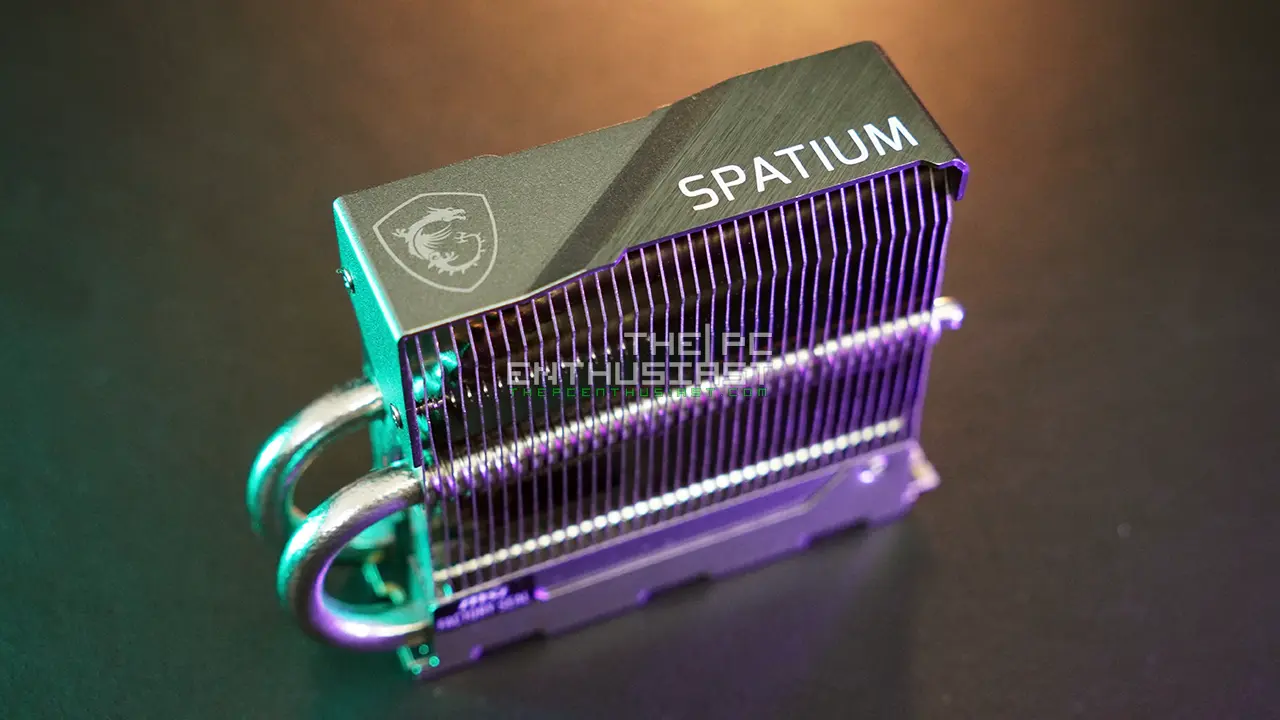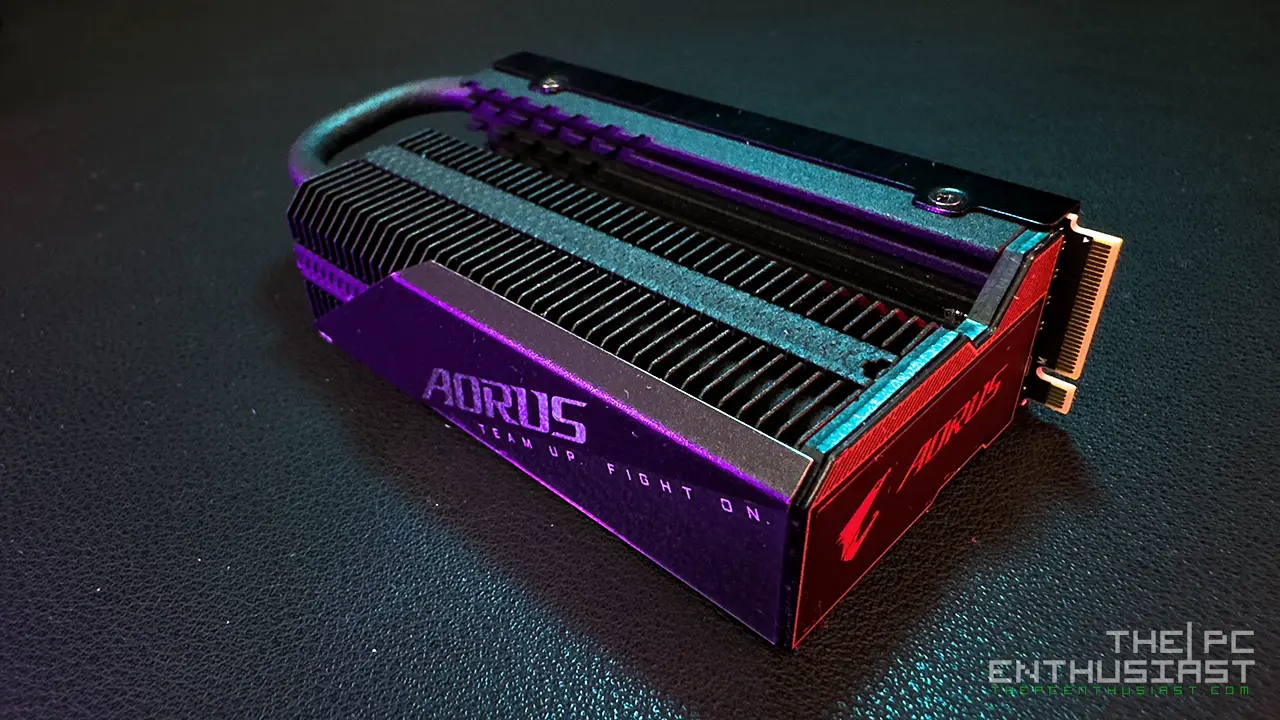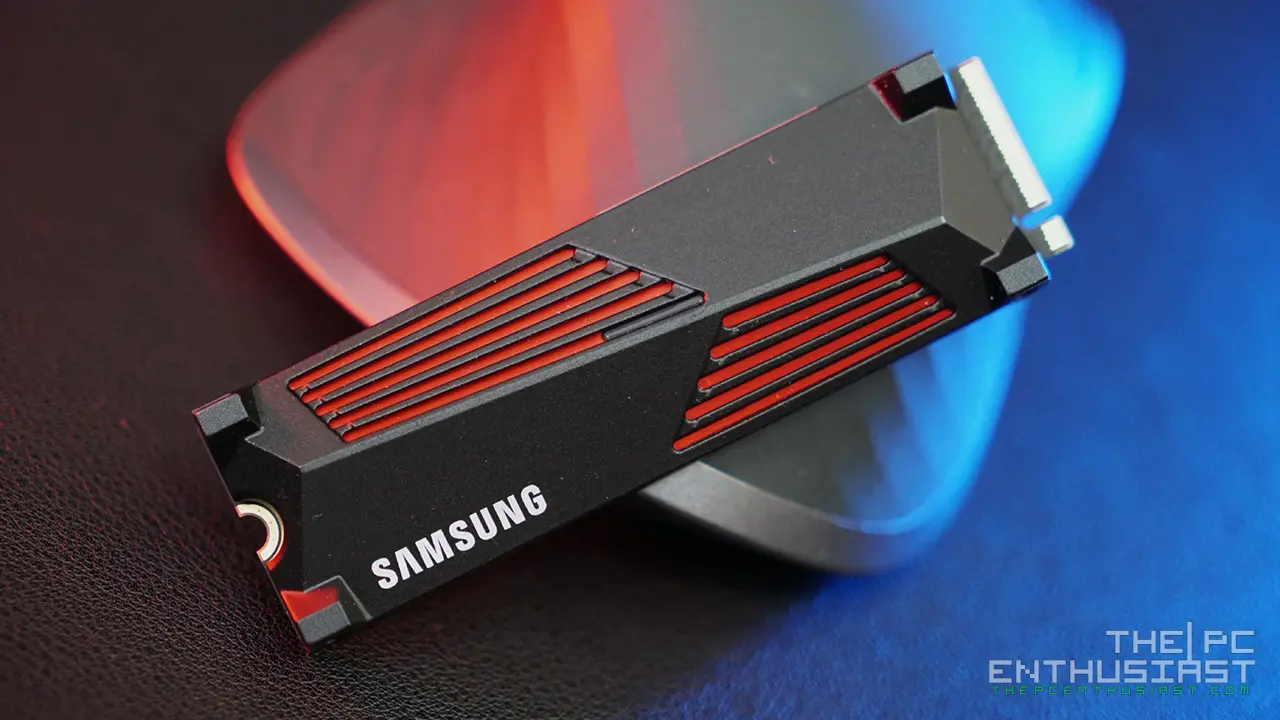These past several months, I have encountered M.2 SSDs using unfamiliar brand components (at least for me) and not from the usual manufacturers/companies. I’m talking about the controller and NAND flash. Usually, the controllers we encounter are from Phison, an in-house controller by WD or Samsung, or NAND flash made by Micron or SK Hynix. However, a few SSDs I have reviewed lately use a controller from MaxioTech and NAND flash from YMTC. Today, I have another M.2 SSD that uses the same controller and NAND flash. We are checking out the Lexar NM790 M.2 SSD 4TB capacity, a DRAM-less SSD that uses these components. The good thing about this drive is its 4TB capacity is cheap. If you’re in the market for a 4TB SSD, check out our review below.

Lexar NM790 M.2 Gen4 SSD 4TB Review – Affordable DRAM-less SSD
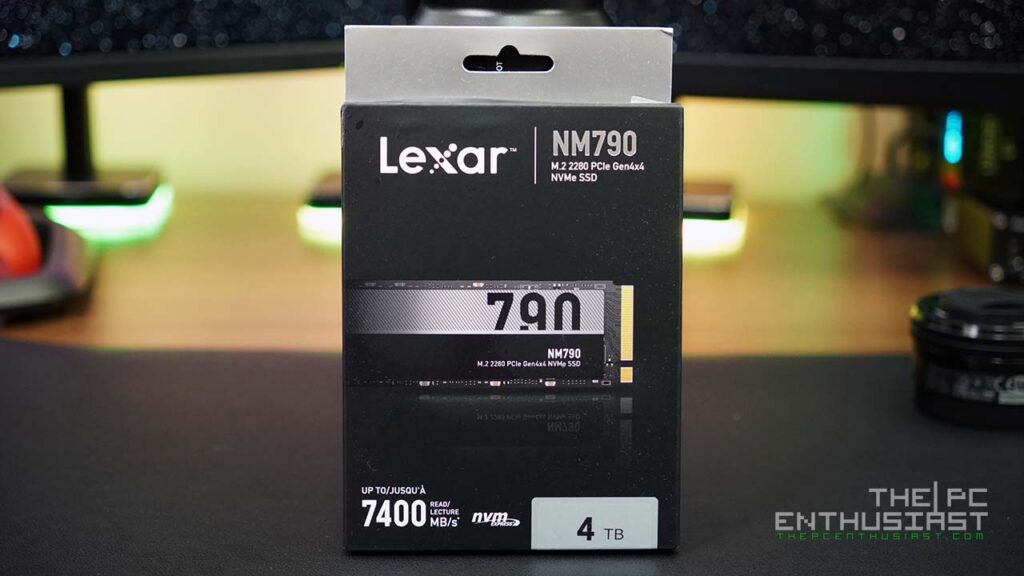
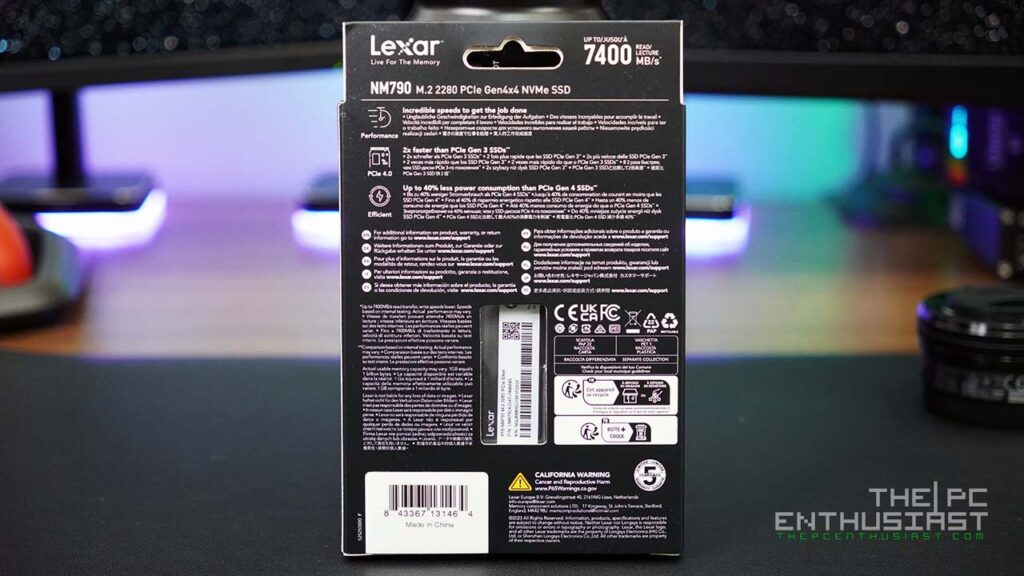
Lexar’s packaging usually has a professional look and feel. It’s an all-black box with silver highlights. You can see a photo of the NM790 M.2 at the front, including its advertised speed and capacity. At the back, you can read additional information about the drive. A small window is also located at the lower middle portion, revealing the drive’s serial number.
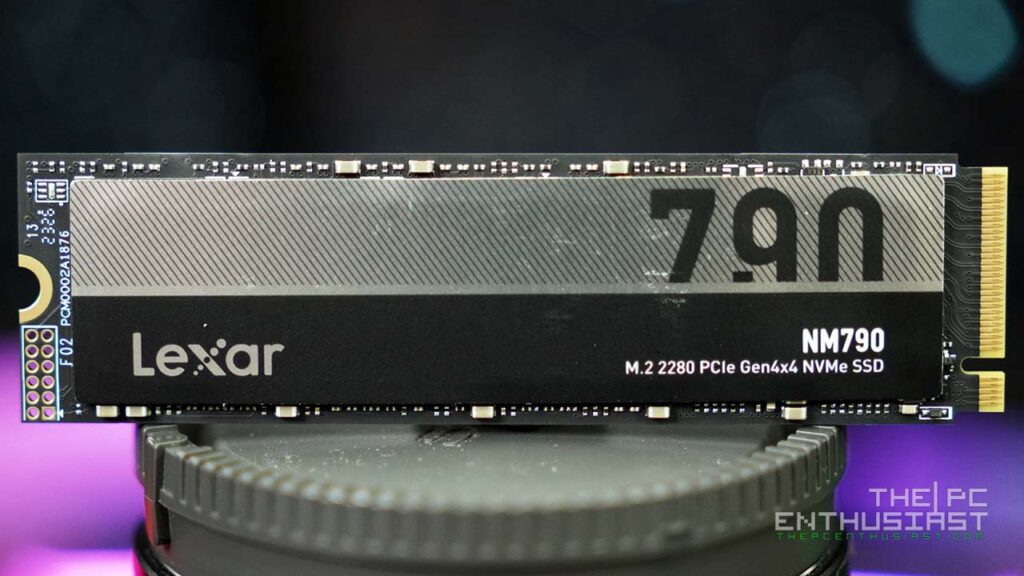
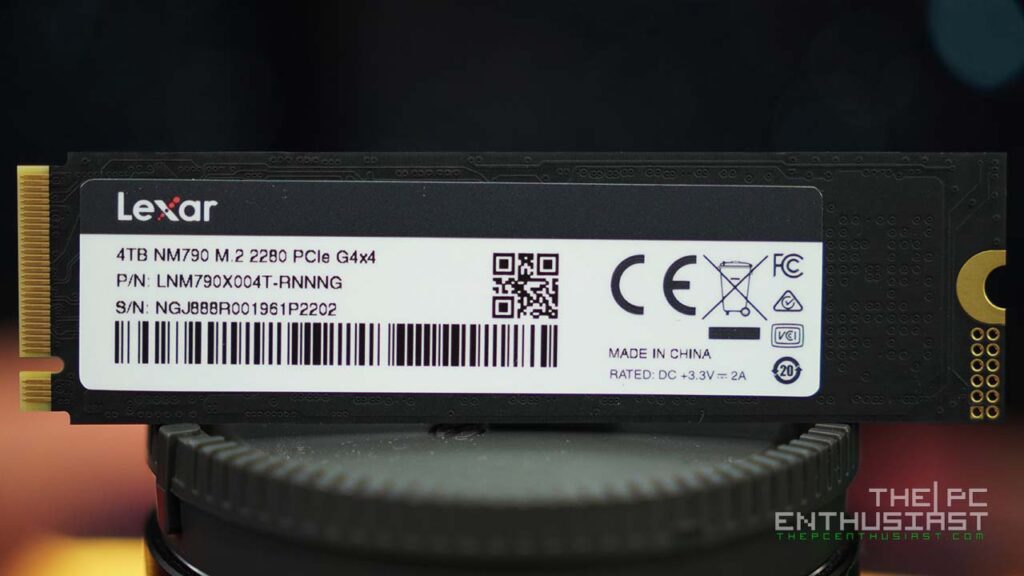
The Lexar NM790 SSD series is available in 512GB, 1TB, 2TB, and 4TB capacities and offers sequential speeds of up to 7,400MB/s read and 6,500MB/s write. Note that the 512GB capacity has slower read and write speeds. I usually avoid lower-capacity M.2 SSDs since they tend to perform slower than the higher-capacity ones.
According to Lexar, the NM790 offers “up to 40% less power consumption than DRAM cache-enabled PCIe Gen 4 SSDs**”. However, I don’t worry about power consumption since M.2 SSDs usually consume much less power than hard disk drives. For laptop users, this may be a good selling point.
Similar to newer NVMe Gen4 M.2 SSDs, the NM790 is not only compatible with desktop PCs and laptops but also with the PlayStation 5. Although, you might need to get a 3rd party heatsink that works with a PS5 since the NM790 doesn’t come with a heatsink.
Lastly, Lexar’s NM790 features Host Memory Buffer (HMB) 3.0, enabling the drive to utilize DRAM memory on your device. It also has Dynamic SLC cache writes to single-level-cell memory to maintain speed “for smooth and seamless performance”.
MaxioTech Controller and Longsys (YMTC) NAND Flash
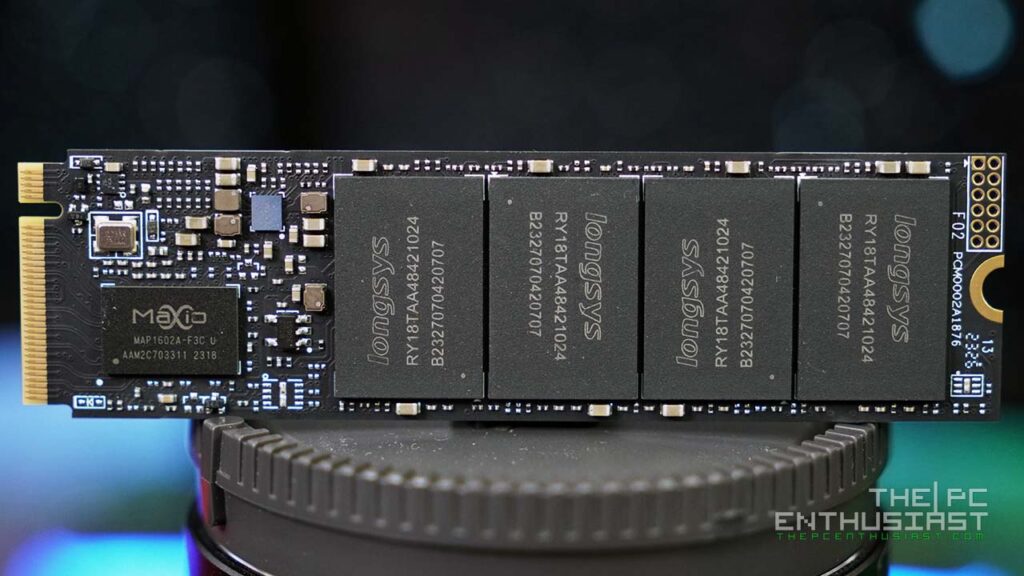
Near the Lexar NM790’s gold fingers is the MaxioTech MPA1602A controller. This controller is specifically designed for DRAM-less SSDs. According to its specs sheet, the MaxioTech MPA1602A can support up to 7,200MB/s and 6,500MB/s of sequential read and write speeds, respectively. Those numbers are close to what Lexar is advertising with its NM790 SSD series.
There are four NAND flash chips on the NM790 4TB capacity, and this SSD is single-sided, making it compatible with some laptops that can’t support double-sided SSDs. The NAND flash used is a Longsys RY18TAA48421024, but it is actually a rebranded YMTC 232-layer 3D TLC NAND. By the way, Longsys is the parent company of Lexar.
Yangtze Memory Technologies Co., Ltd. (YMTC) has yet to have a long track record, as the company was only established in 2016. Meanwhile, its controller is from (Maxiotek/Maxio Tech Corp) a spin-off company of JMicron, also established in 2016. While both companies are around seven years old, I have yet to hear of any (major) issues with their controller and NAND flash.
Anyway, let’s check out how the Lexar NM790 M.2 SSD 4TB capacity performs.
Lexar NM790 M.2 SSD Specifications
| Capacities | 512GB / 1TB / 2TB / 4TB |
| Form Factor | M.2 2280 |
| Interface | PCIe Gen4x4 |
| Speed | 512GB – Sequential read up to 7200MB/s, sequential write up to 4400MB/s 1TB – Sequential read up to 7400MB/s, sequential write up to 6500MB/s 2TB – Sequential read up to 7400MB/s, sequential write up to 6500MB/s 4TB – Sequential read up to 7400MB/s, sequential write up to 6500MB/s |
| Operating Temperature | 0°C to 70°C (32°F to 158°F) |
| Storage Temperature | -40°C to 85°C (-40°F to 185°F) |
| Dimensions (L x W x H) | 80 x 22 x 2.45 mm (3.15” x 0.87” x 0.10”) |
| Weight | 6g / 0.013 lbs. |
| Warranty | Five-year limited warranty |
| Shock-resistant | 1500G, duration 0.5ms, Half Sine Wave |
| Vibration-resistant | 10~2000Hz, 1.5mm, 20G, 1 Oct/min, 30min/axis (X,Y,Z) |
| TBW | 512GB: 500TBW, 1TB: 1000TBW, 2TB: 1500TBW,4TB:3000TBW |
| MTBF | 1,500,000 Hours |
Check the latest pricing and availability: (#ad)
Lexar NM790 SSD Gen4 NVMe M.2 SSD is available on Amazon here.
Test Setup
I tested Lexar’s NM790 4TB capacity on an X670E motherboard with an AMD Ryzen 7 7700X. I installed the drive on the first M.2 slot with the motherboard’s M.2 heatsink. Below are the rest of the system’s specifications:
| Operating System | Windows 11 Pro |
| Processor | AMD Ryzen 7 7700X |
| Motherboard | MSI MPG X670E Carbon WiFi |
| Memory | Corsair Vengeance RGB DDR5-6000MHz CL30 AMD EXPO |
| Graphics Card | Colorful GeForce RTX 4070 Ti iGame Advanced |
| OS Drive | MSI Spatium M480 Play |
| Game Drive | SanDisk Extreme PRO Portable SSD V2 and Extreme Portable SSD V2 |
| Power Supply | MSI MPG A1000G PCIE5 |
| Chassis | MSI MPG Velox 100P Airflow |
| Monitor | MSI Optix MPG321UR-QD 4K 144Hz |
Lexar NM790 M.2 4TB SSD Benchmark Results
Note: Benchmark results below are sorted according to write speed.
AJA Benchmark Results
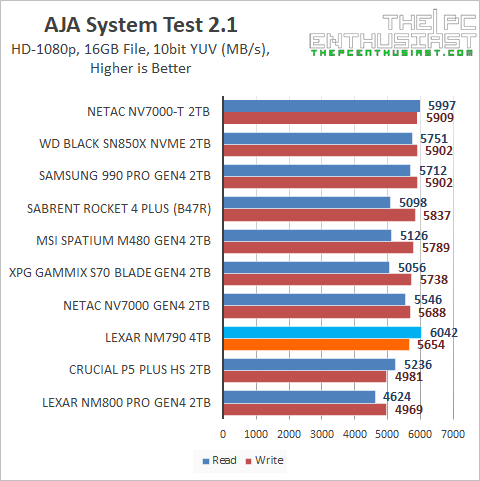
In the AJA System Test, the Lexar NM790 got a pretty good start. While it didn’t end up at the top of the charts when it comes to sequential write speed, it did get the highest sequential read speed among the other SSDs.
AJA System Test is just a quick test and may not represent the drive’s overall performance. Let’s check out more benchmark tests next.
AS SSD Benchmark Results
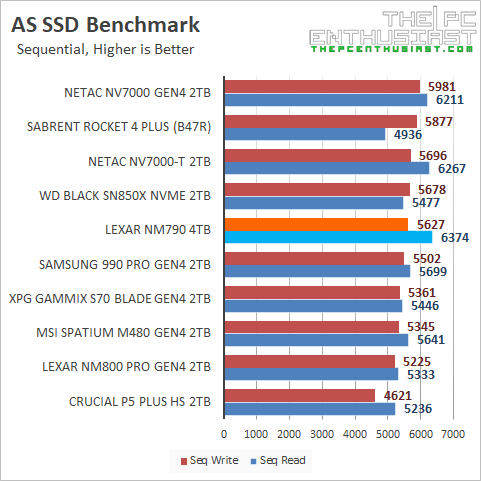
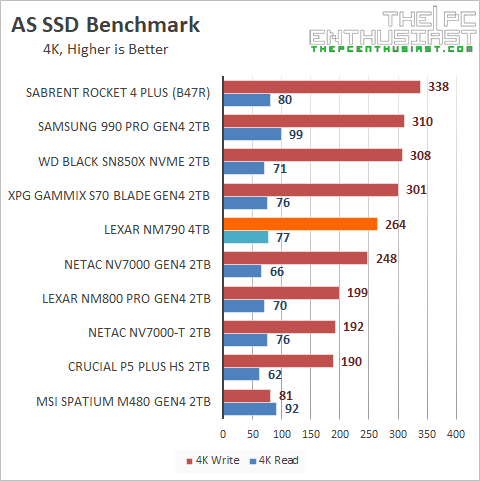
In AS SSD, the Lexar NM790 4TB got a sequential read speed of around 6,300MB/s+ and a sequential write speed of around 5,600MB/s+. Those are still quite impressive results, considering that it is DRAM-less.
When it comes to random test, the NM790 sits in the middle of the SSDs. It’s not the fastest, but it’s not the slowest, either. Random performance is more important, primarily if you work with different file types and/or several smaller files scattered across the drive.
ATTO Disk Benchmark Results

The results I got for the ATTO Disk benchmark test are pretty similar to the ones I got in the AJA Test system. This is purely a sequential test, and the NM790 4TB got reasonably close to its advertised speed.
CrystalDiskMark Benchmark Results
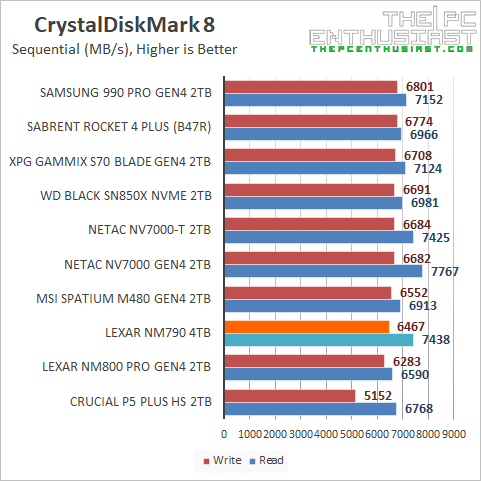

The NM790 4TB SSD sits in the middle of the SSD during the CrystalDiskMark benchmark tests. But at least it hit its advertised sequential speeds of 7,400MB/s read and 6,500MB/s write. Meanwhile, its random test shows that the NM790 can handle different files quite well compared to other SSDs. Now, I’m not quite sure if this is because of its larger 4TB capacity since it is the only 4TB SSD on the graphs. It may have a slight advantage over the 2TB capacity drives.
PCMark 10 Full System Drive Benchmark Results
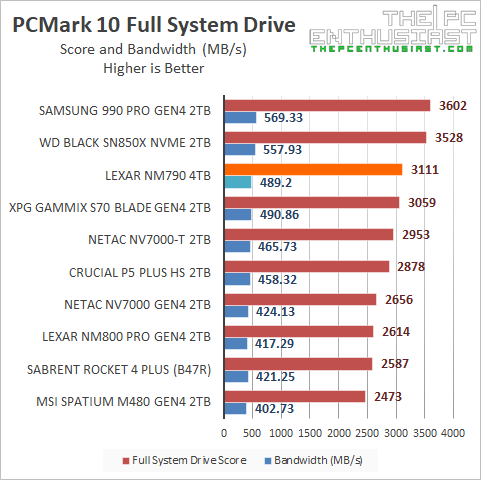
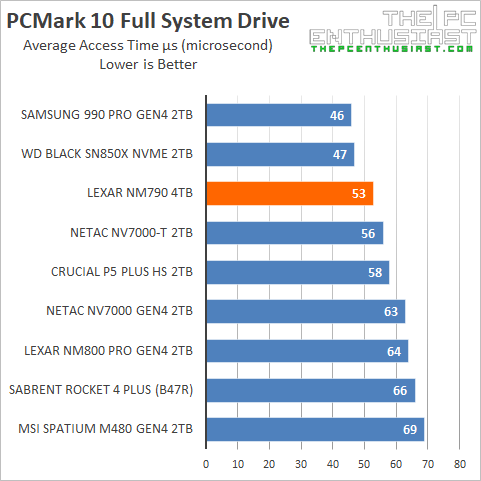
Last but not least, I tested Lexar’s NM790 4TB SSD using the PCMark 10 Full System drive benchmark suite. It is an intensive test and takes about an hour (or more) to finish. The test uses a wide-ranging set of real-world traces from popular applications (Adobe Creative Suite, Microsoft Office) and everyday tasks to test modern drives’ performance thoroughly.
Surprisingly, despite being a DRAM-less SSD, its overall performance is quite good. It even outperformed several SSDs, and it’s pretty near the performance of the WD Black SN850X, an SSD with a DRAM cache. The Samsung 990 Pro is still the fastest Gen4 SSD I have tested. Still, its 4TB capacity is more expensive than Lexar’s offering.
Pricing and Availability
The Lexar NM790 M.2 2280 PCIe Gen 4×4 NVMe SSD is available now at the following manufacturer’s suggested retail prices: 512GB at $49.99, 1TB at $69.99, 2TB at $124.99, 4TB at $209.99. SSD prices tend to change over time, usually dropping after being in the market for quite some time. Retail prices may have changed by the time you land on this review.
Check the latest pricing and availability: (#ad)
Lexar NM790 SSD Gen4 NVMe M.2 SSD is available on Amazon here.
Lexar NM790 M.2 Gen4 SSD 4TB Review Conclusion
Lexar’s NM790 performed as expected, reaching its advertised speeds during the CrystalDiskMark benchmark. Also, it performed generally faster than Netac’s NV7000-T, which is also a DRAM-less SSD. The NV7000-T also uses the same MaxioTech controller and YMTC NAND flash. I guess NM790’s higher 4TB capacity did help in the overall performance. Or perhaps Lexar has better fine-tuning/firmware than Netac’s SSD.
The brand Lexar has been in the market for quite some time now. And they have established their reputation as a storage solution for professionals. I don’t have anything to complain about the NM790’s performance. It’s pretty good, actually, for a DRAM-less SSD. Do note that the drive I tested has a 4TB capacity, and the performance for the 2TB and 1TB capacities may not be similar. The 512GB will obviously be slower, and I would not advise getting a lower-capacity SSD.
However, I am more worried about the quality or longevity of the controller and the NAND flash. I’m unfamiliar with MaxioTech and YMTC; they don’t have a long track record or history yet. Nevertheless, the NM790 4TB performed as expected. It’s not the fastest Gen4 M.2 SSD drive around, but for its price, it is good enough.
I recommend not using this as your primary SSD or system drive. Also, if you ever put some important files in this drive, ensure you have a backup. When an SSD fails, they tend to die suddenly without any notice. This reminder is not limited to Lexar’s NM790 alone but in general.
Is It Worth It?
If the price is right, usually below $200 for the 4TB capacity, it’s worth considering the Lexar NM790. Again, this is a DRAM-less drive, and if you require an SSD with a cache, you might look elsewhere. However, for gaming purposes, file storage, and perhaps for editing images and videos, the NM790 is a fast and cost-effective storage solution.



